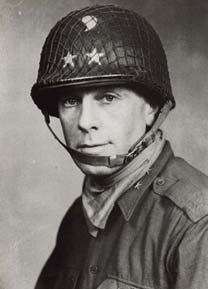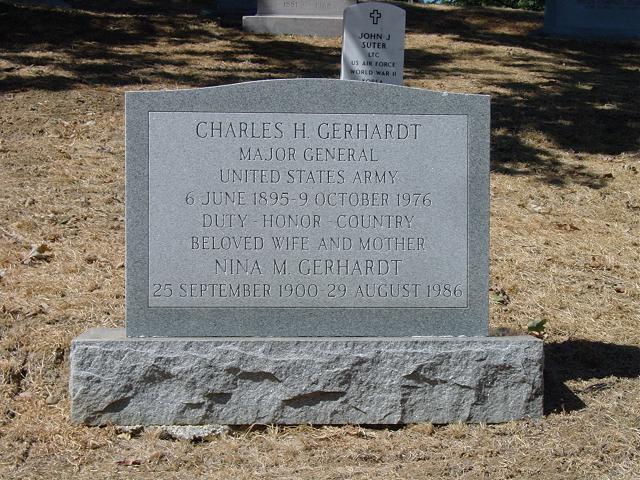
On July 18, 1944, after 43 days of incessant combat following its landing on Omaha Beach, the U.S. 29th Infantry Division, under the command of Major General Charles Hunter Gerhardt, entered Saint-Lo, France.
His wife Nina Gerhardt. His father was Charles Gerhardt, Brigadier General, United States Army.
The Commanding General was Charles H. Gerhardt who was probably the most controversial general in the war. I knew him when he commanded the 29th Infantry Division in Europe. After the war he was reduced to Lieutenant Colonel for having wasted so many men at St. Lo and the Sportplatz at Julich.
The 29th Infantry Division, commanded by Major General Charles H. Gerhardt, was originally a National Guard unit, with soldiers from Washington, D.C., Maryland, Virginia and Pennsylvania. It had fought in the Meuse-Argonne campaign during World War I and was one of the first U.S. divisions shipped to Europe in 1942. The 29th was part of Major General Leonard T. Gerow’s V Corps. The division consisted of the 115th, 116th and 175th Infantry Regiments. The 116th RCT was reinforced by an additional 500 men in expectation of high casualties.
The 29th Division fought in World War I but is most famous for its record in World War II. Comprised then of Guard units from Maryland, Virginia and the District of Columbia, it was the first Army division to reach England, arriving in 1942.
Held back for a planned invasion of France, the division spent nearly two years training there. So long, in fact, it earned the derisive moniker, “England’s Own.” But Major General Charles H. Gerhardt, 29th division commander, had another motto in mind. He wanted something with a forward tilt. So he coined the battle cry that lives to this day: “29, Let’s Go.”
Gerhardt’s motto was appropriate. Beginning on D-Day, June 6, 1944, the division fought 242 days over the next 10 plus months, stopping only when it reached the Elbe River in Germany to wait for the Russian Army approaching from the east. It suffered 20,111 casualties, more than any other Army division other than the 1st Division, which also fought in North Africa and Italy. The running joke in France was that Gerhardt had three divisions: one in the field, one in the hospital and one in the cemetery.
The 29th Infantry Division (“Blue and Grey”)
Major General Charles H. Gerhardt, Commanding
The 116th Infantry Regiment from the Division landed at Omaha Beach and were involved in the Battles of St Lo, Vire, Mortain and Brest.
Major General Charles Hunter Gerhardt, 29th Infantry Division Commanding Officer, nicknamed “Uncle Charlie” or ” Jumping Charley.”
In July 1943 Major General Charles Hunter Gerhardt assumed command of the Blue and Gray. Balkoski devotes a large section of his “England” chapter to describing the new CO and his impact on the division. He was a demanding officer who wanted his men to look like soldiers, act like soldiers, and know the business of soldiers. He was also not above petty demands that, for example, had his aide and divisional cooks scrambling to oblige his sudden craving to have waffles for his breakfast. Later, the story is also told how, among the debris and corpses on Omaha Beach, on the morning of D+1 Gerhardt chewed out a passing GI for dropping orange peels in the sand.
Major General Charles Hunter Gerhardt (June 6, 1895-October 9, 1976) commanded the U.S. 29th Infantry Division from 1943 until the end of World War II and during part of the occupation of Germany. The division’s most famous combat actions are the Omaha Beach landings of June 6, 1944, D-Day and the taking of the French crossroads town of Saint-Lô in July 1944.
Major General Charles GerhardtGerhardt grew up in the Army as the son of a career officer who would retire as a Brigader General. The younger Gerhardt attended the United States Military Academy at West Point where he earned a reputation as a skilled football, baseball and polo player. In 1916, Gerhardt quarterbacked West Point to a 30-10 upset win over Notre Dame, which was led by the famed freshman George Gipp. It was Notre Dame’s only loss that year. Upon graudation he was commissioned a Second Lieutenant of Cavalry and served during World War I with the 89th Division. In 1932, Gerhardt was selected as a judge in the equestrian events for the 1932 Olympic Games held in Los Angeles, California. His senior command prior to leading the 29th Infantry Division was as the commanding general of the 91st Infantry Division at Camp White, Oregon.
Gerhardt was a hard taskmaster, strict disciplinarian and considered by many of his men to be a martinet, who often became upset at small things such as a soldier not having the chinstrap of his helmet buckled. One famous story has him admonishing a soldier on the day after D-Day for dropping peels from the orange he was eating on the ground. Gerhardt was, however, a superb and driven trainer of soldiers and expected the same from his commanders.
Gerhardt was also one of the European Theater’s more controversial generals. His critics held that he was lacking as a military tactician and careless with the lives of his men; often pointing to the astonishingly high casualty rate of the 29th Division. It was said that Gerhardt actually commanded three divisions: one on the field of battle, one in the hospital and one in the cemetery. He was also considered somewhat loose morally, as evidenced by a house of prostitution he established for his men near Rennes, France, which General Omar N. Bradley did not approve of and ordered closed. Gerhardt usually walked the line between approval and disapproval with his superior officers. After the war, he was demoted to Colonel for reasons thought to be a combination the 29th Division’s high casualty rate and his moral lapses.
Following World War II Gerhardt served as the United States Defense Attaché to Brazil and in a post at Fort Meade, Maryland. He reattained the rank of Brigadier General and was able to retire at his highest held rank of Major General.
Gerhardt is buried at Arlington National Cemetery.
MAJOR GENERAL CHARLES GERHARDT, 81
Commanded 29th Infantry on D-Day
WINTER PARK, Florida, October 10, 1976 – Major General Charles H. Gerhardt, who commanded the landing of the 29th Infantry Division in Normandy on D-Day, died of a heart attack here yesterday. He was 81 years old.
General Gerhardt graduated from Wet Point in 1917 and served with the 89th Division until the end of World War I. Later he was with the 8th, 11th and 14th Cavalry Divisions and also served in the Philippines.
He commanded the 29th Infantry throughout the European campaign and in 1952, retired from the Army after 27 years of service, having been awarded the Distinguished Service Medal and the Silver Star.
Michael Robert Patterson was born in Arlington and is the son of a former officer of the US Army. So it was no wonder that sooner or later his interests drew him to American history and especially to American military history. Many of his articles can be found on renowned portals like the New York Times, Washingtonpost or Wikipedia.
Reviewed by: Michael Howard

